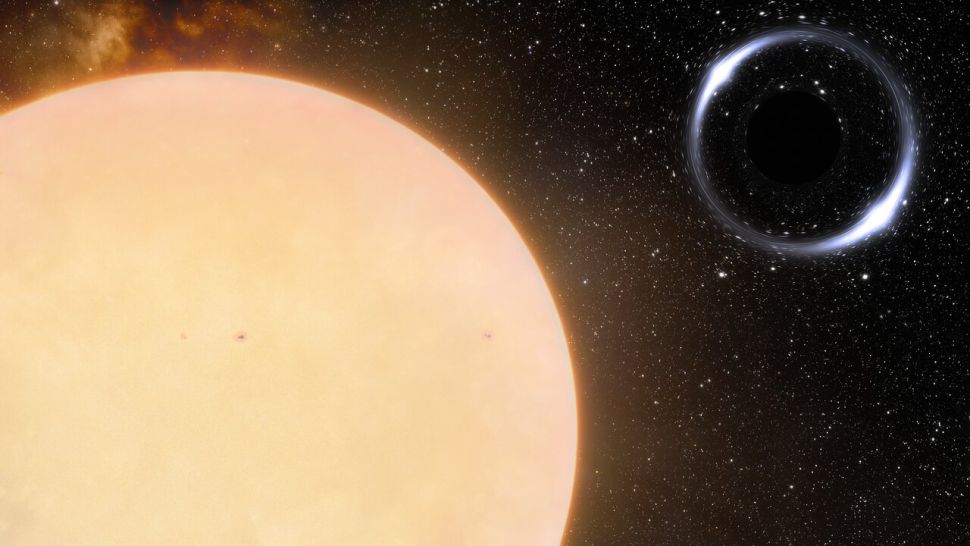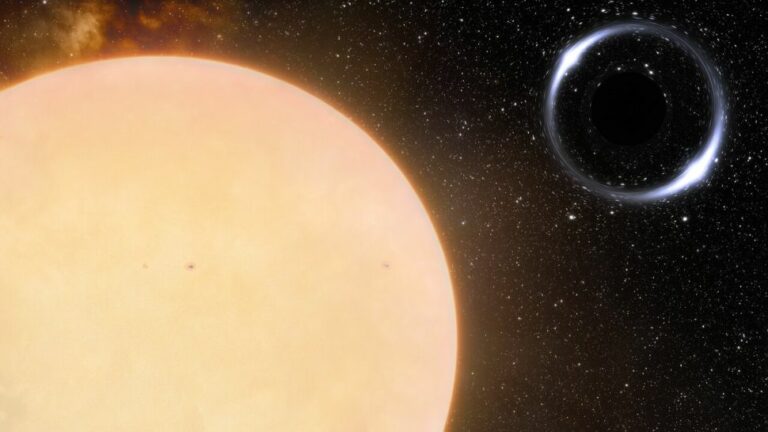Breaking records! The nearest black hole to Earth has been discovered.
Breaking records! The nearest black hole to Earth has been discovered.
Just now, the black hole history books were updated.
According to a recent research, there is a black hole only 1,560 light-years from Earth that is nearly 10 times as large as our sun. That is about twice as near as the previous champion in closeness.
The newly discovered object, known as Gaia BH1, is a stellar-mass black hole that is one of two stars in a binary system. Gaia BH1 is a pretty unusual star indeed since it is located almost as distant from its partner black hole as the Earth is from the sun.

According to study lead author Kareem El-Badry of the Harvard-Smithsonian Center for Astrophysics in Massachusetts and the Max Planck Institute for Astronomy in Germany, “there have been many claimed detections of systems like this, but almost all of these discoveries have subsequently been refuted.” The discovery of a sun-like star in a broad orbit around a stellar-mass black hole in our galaxy is new and unequivocal.
About 100 million stellar-mass black holes, which are light-sucking monsters five to one hundred times more massive than the sun, are thought to exist in the Milky Way galaxy.
However, because of their tiny size, these bodies are very challenging to find, especially via telescope. (Recently, gravitational-wave detectors have found evidence of mergers involving these objects with more success.) The ones that are observed by scientists are often “X-ray binaries,” which are black holes that collect matter from a partner star and gather it in an accretion disk around themselves. Some extremely strong telescopes can observe the high-energy X-rays that this fast-orbiting dust and gas releases.
Although some stellar-mass black holes in binary systems are actively feeding, not all of them are. It is considerably harder to locate these inactive items, and other approaches are needed.
In the recent study, the researchers used one such alternative methodology. They studied information acquired by the Gaia satellite of the European Space Agency (ESA), which is accurately charting the locations, speeds, and trajectories of around 2 billion Milky Way stars.
The Gaia BH1 companion is one of such stars. Tiny abnormalities in its velocity are a sign that something large and invisible is pulling on it gravitationally.
The Gaia measurements hinted that a black hole may be that tugger, but additional information was required to be certain. The Gemini North and Keck 1 telescopes in Hawaii, the Magellan Clay and MPG/ESO telescopes in Chile, and other ground-based telescopes were used to study the star.
The team was able to thoroughly assess the system thanks to these subsequent observations and the Gaia data. They found that the unknown object circles the system’s mass center once every 186 Earth days and has a mass of 10 suns. It must be a black hole as well.
Beyond a shadow of a doubt, El-Badry stated, “our Gemini follow-up observations showed that the binary comprises a typical star and at least one inactive black hole.” There is no conceivable astrophysical explanation for the system’s observed orbit that does not include at least one black hole, according to our research.
For instance, if the unknown object in Gaia BH1 were a star, it would be far more visible since it would be much brighter than its partner. However, not a single observation made by the researchers indicated that the system had a second star.
Not simply because it is nearby, but also for other reasons, the Gaia BH1 system is fascinating. (Close in the grand scale of things; the renowned spiral disc of the Milky Way is around 100,000 light-years across.) The research team doesn’t know how the star and black hole ended up where they did.
The star that perished and gave rise to Gaia BH1 must have been massive, at least 20 solar masses or thereabouts, based on its mass. Such giants puff up enormously before passing away after only a few million years of existence.
According to modeling, such puffing would have probably killed the companion before it could have developed into a sun-like star (if the two were born at the same time). Or, if it had lived, the researchers claimed, it should have ended up in an orbit that was considerably tighter than the one it is in right now.
It’s intriguing that this system is difficult for traditional binary evolution models to account for, El-Badry commented. The formation of this binary system and the number of these latent black holes in the universe are two of the many mysteries raised by this.
Today, November 4, the new work was made available online in the journal Monthly Notices of the Royal Astronomical Society.
Source:SpaceCom
Do not forget to share your opinion with us to provide you with the best posts !





0 Comments